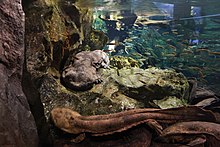Andrias japonicus
| Japanese giant salamander | |
|---|---|
 |
|
| In Kyoto Aquarium | |
| Scientific classification | |
| Kingdom: | Animalia |
| Phylum: | Chordata |
| Class: | Amphibia |
| Order: | Caudata |
| Family: | Cryptobranchidae |
| Genus: | Andrias |
| Species: | A. japonicus |
| Binomial name | |
|
Andrias japonicus (Temminck, 1837) |
|
| Synonyms | |
|
Megalobatrachus japonicus (Reviewed by Sato 1943) |
|
Megalobatrachus japonicus (Reviewed by Sato 1943)
The Japanese giant salamander (Andrias japonicus) is endemic to Japan, where it is known as Ōsanshōuo (オオサンショウウオ/大山椒魚), literally meaning "giant pepper fish". With a length of up to almost 1.5 m (5 ft), it is the second-largest salamander in the world, only being surpassed by the very similar and closely related Chinese giant salamander (A. davidianus). There are only three known members of the Cryptobranchidae family: the Japanese and Chinese giant salamanders and the Eastern hellbender.
Japanese giant salamanders are widespread across rivers in southwestern Japan. The species frequently hybridizes with Chinese giant salamanders, which were introduced to the area.
Japanese Giant Salamanders can grow to be five feet long (160 cm) and 55 pounds (25 kg). The largest wild specimen on record weighed 26.3 kg and was 136 cm long. It is the second largest amphibian in the world, only next to its close relative, the Chinese Giant Salamander. Their brown and black mottled skin provides camouflage against the bottoms of streams and rivers. They have very small eyes with no eyelids and poor eye sight. Their mouths run across the width of their heads, and can open to the width of their bodies.
They can be distinguished from Chinese Giant Salamanders by the arrangement of tubercles on the head and throat. The tubercles are larger and more numerous compared to the mostly single and irregularly scattered tubercles of the Chinese Giant Salamander. The snout is also more rounded and the tail is slightly shorter.
There is no visual external sexual dimorphism.
The Japanese giant salamander, being restricted to streams with clear, cool water, is entirely aquatic and nocturnal. Unlike other salamanders, which lose their gills early in their lifecycles, they only breach their heads above the surface to obtain air without venturing out of the water and onto land. Also due to their large size and lack of gills, they are confined to flowing water where oxygen is abundant. The salamander absorbs oxygen through its skin, which has many folds to increase surface area.
...
Wikipedia

